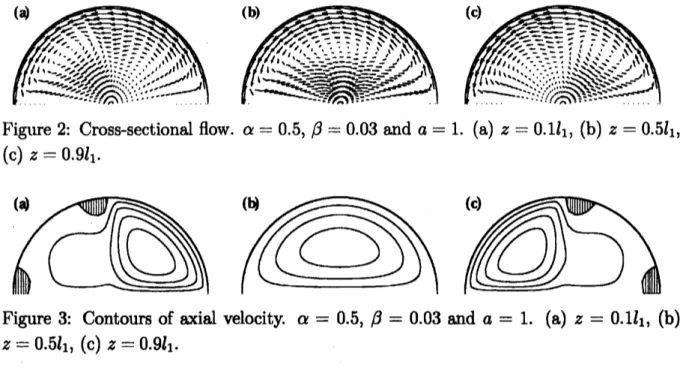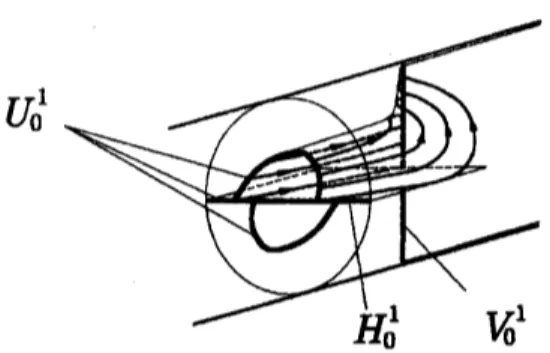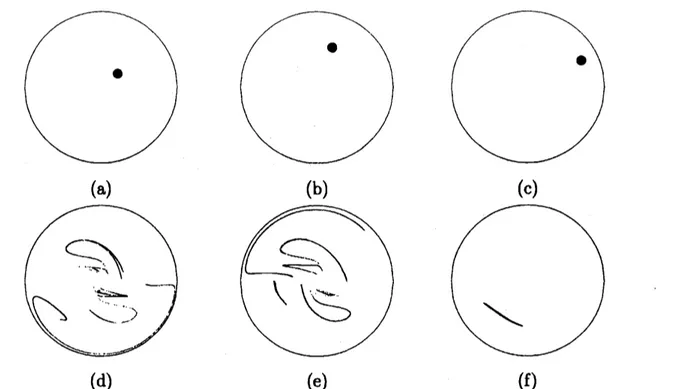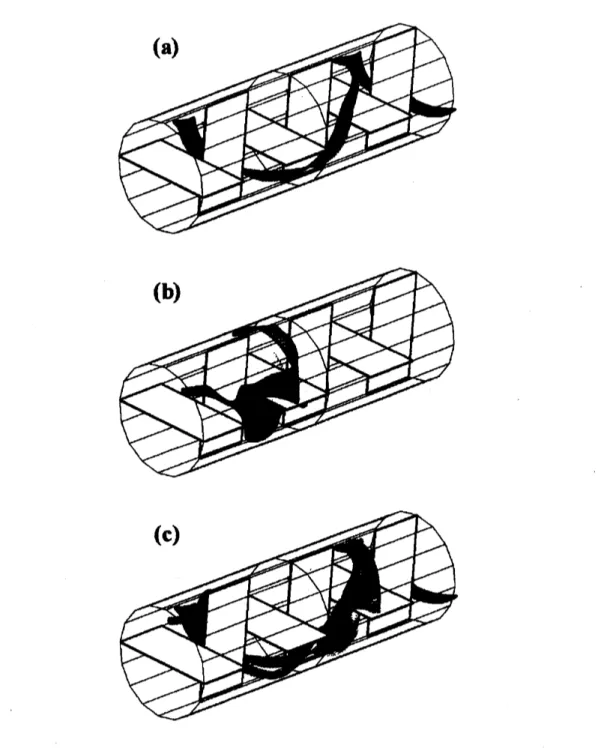Chaotic mixing due
to
aspatially periodic three-dimensional
flow
京都大学大学院情報学研究科水野吉規 (Yoshinori Mizuno), 船越満明 (Mitsuaki Funakoshi)
Graduate School ofInformatics, Kyoto University
1
Introduction
Mixing of afluid has been studied
on
the basis of theories of dynamical systems. Itis known that Stokes flow
or
aflow with low Reynolds numberscan
mix the fluid wellwithin aregion where the trajectories of fluid particles
are
chaotic, called chaotic regionhereinafter,
even
if the velocity field itself behaves regularlyor
is steady if it isthoee-dimensional (Ottino (1989), Ottino (1990) and Aref (1990)). Partitioned pipe mixer
(PPM) is one ofthe systems studied from the viewpoint of dynamical systems (Khakhar
et al. (1987), Ling (1993) and Meleshko et al. (1999)$)$
.
This system first introduced byKhakhar et al. originally consists of
an
infinitely long cylinder and plane plates ofthesame
length fixed orthogonallyto
each other. Figure $1(\mathrm{a})$ shows schematic view ofone
period of the original PPM. Rotation ofthe cylindrical wall and pressure gradient in the
axial direction
cause
aflow in this system. In Khakhar et al. (1987) and Meleshko et al.(1999) that
are
basedon
approximate velocity fields, it is shown that chaotic mixingcan
occur
inthis system. Mizuno and Funakoshi (2002) thengeneralizedthe PPMso
thattheratio of the lengths of neighboringplates
or
the angle between themcan
bechanged. Oneperiod ofthe generalized PPM is shown in Fig.l(b). Inthe examination of the mixing of
afluid within the generalized PPM, it is shown that the chaotic region
can
occupy the$\backslash$
almost whole region ifthe ratio or the angle is appropriately changed.
Generally, there exists regions that donot mix quickly with the surrounding fluid
even
within chaotic regions. It is confirmed by calculating the distribution of stretching rate
offluid elements(Muzzio et al. (1991)). Capturing theexistenceand distribution of these
regions needs to understand the mixing process there. In the experimental study
on
themixing in PPM by Kusch and Ottino (1992), it
was
noted that the separation of thefluid by the leading edges of plane plates is acontributing mechanism to the mixing.
Although they also noted that chaos
can
occur
without anycutting mechanism, thecon-sideration of this mechanism which static mixers commonly possess is expected to be
a
useful approach to understanding the mixing process in these mixers. Hence, Mizuno
and Funakoshi (2002) focused
on
the separation of the flow by the leading edges, andexamined the efficiency of the mixing within the chaotic region by introducing the lines
of
separation, definedas
the set ofcross-
ectional initial locations of fluid particles whichmove
toone
of the leading edges of the plates within aspecified period. Consequently,it
was
found that the lnes ofseparationplaysan
important role in the estimation ofthe数理解析研究所講究録 1339 巻 2003 年 23-34
Figure 1: Schematic view ofPPMs. (a) Original PPM. (b) Generalized PPM.
mixing performance inafew periods.
However,it should benoted that thevelocityfieldsin the precedingstudies
are
assumedtobe independent of theaxial coordinatewithineachregionaround each plate, hereinafter
an
element, and to change discontinuously at the cross-sections between neighboringel-ements. The validity of these assumptions is not clear. Therefore,
we
here calculate thevelocityfield numerically without these assumptions, and examine the mixing of afluid,
especially in
one
period. Furthermore,we
will show that the consideration of thesep-aration by the leading edges help to understand the mixing process within the chaotic
region.
2Velocity field in PPM
Let $(r, \theta)$ be the polar coordinates in the cross-sectional direction of
aPiPe
with radius$R$, and $z$ be the coordinate in its axial direction. The cylindrical $\mathrm{w}\mathrm{a}\mathrm{U}r$ $=R$ of the pipe
is assumed to rotate at constant velocity $V$. Horizontal platesof length $L_{1}$ expressed by
{
$(r,\theta,z)|0\leq r\leq R$, $\theta=0$or
$\pi$, $k(L_{1}+L_{2})<z$ $<k(L_{1}+L_{2})+L_{1}$}
and verticalplatesoflength $L_{2}$ expressed by
{
$(r,\theta,z)$ $|0\leq r\leq R$,
$\theta=\pi/2$or
$3\pi/2$, $k(L_{1}+L_{2})+L_{1}<z$ $<$$(k +1)(L_{1}+L_{2})\}$
are
placed alternatelywithin this pipe, where A $=0,$$\pm 1,$$\pm 2$,$\cdots$.
Assuming the spatial periodicity in the axial directionof the system,
we
take the flowregion
as
$\mathrm{D}=\{(r,\theta,z)|0<r<R, 0<\theta<2\pi, : 0<z<L_{1}+L_{2}\}$
.
We here
assume
the steady Stokes flow in region D. If the velocity field and pressureare
$v=(v_{r}, v_{\theta},v_{z})$ and $P$, respectively, the equation of continuity and the $\mathrm{N}\mathrm{a}\mathrm{v}\mathrm{i}\mathrm{e}\mathrm{r}\sim \mathrm{S}\mathrm{t}\mathrm{o}\mathrm{k}\mathrm{s}$equation under the Stokes approximation
are
given by$\nabla\cdot v=0$, (1)
$- \frac{\partial P}{\partial r}+\beta(\frac{\partial^{2}v_{r}}{\partial r^{2}}+\frac{1}{r}\frac{\partial v_{r}}{\partial r}+\frac{1}{r^{2}}\frac{\partial^{2}v_{r}}{\partial\theta^{2}}+\alpha^{2}\frac{\partial^{2}v_{r}}{\partial z^{2}}-\frac{v_{r}}{r^{2}}-\frac{2\partial v_{\theta}}{r^{2}\partial\theta})=0$
,
(2)$- \frac{1}{r}\frac{\partial P}{\partial\theta}+\beta(\frac{\partial^{2}v_{\theta}}{\partial r^{2}}+\frac{1}{r}\frac{\partial v_{\theta}}{\partial r}+\frac{1}{r^{2}}\frac{\partial^{2}v_{\theta}}{\partial\theta^{2}}+\alpha^{2}\frac{\partial^{2}v_{\theta}}{\partial z^{2}}-\frac{v_{\theta}}{r^{2}}+\frac{2}{r^{2}}\frac{\partial v_{r}}{\partial\theta})=0$,
$- \alpha^{2}\frac{\partial P}{\partial z}+\beta(\frac{\partial^{2}v_{z}}{\partial r^{2}}+\frac{1}{r}\frac{\partial v_{z}}{\partial r}+\frac{1}{r^{2}}\frac{\partial^{2}v_{z}}{\partial\theta^{2}}+\alpha^{2}\frac{\partial^{2}v_{z}}{\partial z^{2}})=0$,
(3) (4) $v=0$
on
$\{$ $\theta=0,\pi$, $0<z<l_{1}$, $\theta=\frac{\pi}{2}$,$\frac{3\pi}{2}$,
$l_{1}<z<2$, (5) $v_{r},v_{z}=0$, $v_{\theta}=1$on
$r=1$, (6) $v(z=0)=v(z=2)$,
$P(z=0)=P(z=2)+1$, (7) where$\alpha=\frac{R}{(L_{1}+L_{2})/2}$, $\beta=\frac{\mu V}{RP_{d}}$, $l_{1}= \frac{L_{1}}{(L_{1}+L_{2})/2}$,
and
we
non-dimensionalized thelength in the cross-sectionaldirection, length inthe axialdirection,
velocities
in the cross-sectional direction, velocity in the axial direction andpressure with $R$, $(L_{1}+L_{2})/2$, $V$, $(L/R)V$ and $P_{d}$, respectively. Here $\mu$ and $P_{d}$
are
theviscosity of the fluid and the pressure drop during
one
period in the axial direction,respectively. The parameter $\alpha$ is the aspect ratio ofthe system, and $\beta$ is the ratio ofthe
representative velocity of the cross-sectional flow due to the rotation of the cylindrical wall to that of the axial flow due to the pressure gradient.
The boundary value problem (1)$-(7)$ is solved numerically. We here assume that the
velocity and pressure fields have the symmetry with respect to the rotation by $\pi$ around
the $z$ axis. Hence,
we
restrict the range of0to
$(0, \pi)$.
Since the velocity field changeslargely in the regions around $z=0$, $l_{1}$ and 2,
we
use
acoordinate $\langle$ that is stretchedwithin these regions instead of$z$
.
The relation between $z$ and $\langle$ is given by$z=\{pq\{$$\{$
$\frac{1}{2}+\epsilon)\pi\zeta-\frac{1}{2}$$\mathrm{c}\mathrm{o}\mathrm{e}(\pi\zeta)$$\sin(\pi\zeta)\}$, $0<\zeta<1$ $\frac{1}{2}+\epsilon\frac{p}{q})\pi(\zeta-1)-\frac{1}{2}\cos(\pi(\zeta-1))\sin(\pi(\zeta-1))\}+l_{1}$, $1<\zeta<2$,
(8)
where
$p= \frac{l_{1}}{\pi/2+\epsilon\pi}$, $q= \frac{2-l_{1}+4\epsilon(1-l_{1})}{\pi/2+\epsilon\pi}$,
and $\epsilon$ is
anon-zero
value chosenso
that $| \frac{\ }{d\zeta}|\neq 0$ at ( $=0,1,2$.
We choose $\epsilon=0.5$ for$a=1.0$, $\epsilon=0.3$ for $a=1.85,2.33$
,
and $\epsilon=0.2$ for $a=3.0$.
We obtain the velocityfieldsatisfying Eqs.(1)-(7)
as
the steady solution to$\nabla\cdot$ $v=0$, and, $\frac{\partial v}{\partial t}=-\mathrm{f}\mathrm{f}\mathrm{f}\mathrm{f}\mathrm{i}P$$+\beta\nabla^{2}v$, (9)
with boundary conditions (5)$-(7)$ by
SMAC
method (Ferziger and Peric (1999)) withfi-nite difference method
on
astaggered grid. The accuracy of the discretization issecon
Figure 2: Cross-sectional flow, $\alpha=0.5$, $\beta=0.03$ and $a=1$
.
(a) $z=0.1l_{1_{7}}(\mathrm{b})z=0.5l_{1}$,(c) $z=0.9l_{1}$
.
Figure 3: Contours of axial velocity, $\alpha=0.5$, $\beta=0.03$ and $a=1$
.
(a) $z=0.1l_{1}$, (b)$z=0.5l_{1}$, (c) $z$ $=0.9l_{1}$
.
order, and the number of the grid points is 40 $\mathrm{x}40\mathrm{x}80$
.
The cross-sectional flow and contours ofthe axial velocity at three axial positions
are
shown in Figs.2 and 3, respectively. Only the upper parts
are
shown in these figures.The wall rotation generates vortical flows in the cross-sectional direction at all the axial
positions, as seenin Fig.2. In the axialdirection, althoughtotalfluxispositivebecause of
the pressure drop inthe axial direction,
we
can
recognize backward flowsnear
the ends ofthe plate,
as
shown in Figs.3(a) and (c), where backward flowsoccur
within the hatchedregions. These backwardflows
are
caused bythe wall rotation. Incontrast to theapprox-imate velocityfields used in the precedingstudies, there
can
be orbits wandering betweenneighboring elements for along time and also closed orbits because of the backwardflow.
Although the former orbits
are
chaotic, they stay within apair of neighboring elementsfor along time. Since such orbits are not appropriate for amixing device,
we
choose thesmal value of$\beta$
so
that the region in which the axial velocity has backward direction issmall. Backward flow was also observed in the experimental study by Kusch and Ottino
(1992).
3Results
Once avelocity field is obtained,
we can
track the trajectories of fluid particles byintegrating ordinary differential equation
$\frac{dx(t)}{dt}=v(x(t))$, (10)
where $x(t)$ is the position of afluid particle, and t is the time non-dimensionalized by
$R/V$
.
Since the velocity is periodic in the axial direction,
we
here consider amap definedas
$M_{z_{0}}$ : $(r,\theta)\mapsto(r(T(r,\ )), \theta(T(r,\theta)))$, (11)
where $T(r, \theta)$ is the minimum time which satisfies
$\int_{0}^{T(r\beta)}v_{z}(t)dt.=2$, (12)
on
thetrajectoryofEq.(lO) starting from $(r, \theta, z_{0})$ at $t=0$.
This mapping represents thecross-sectional movement ofthe fluid particle initiallylocated at $(r, \theta)$
on
$z=z_{0}$ afterone
period in the axial direction, and $T(r,\theta)$ is the time required for the movement.
3.1
Poincare
sections
In the preceding studies based
on
the approximate velocityfield andalso in theexper-imental study, tubular invariant sets of the trajectories, called KAM-tubes hereinafter,
that prevent thetransport of fluidparticlesbetweenitsinside and outside
were
recognizedfor
some
sets of the values of system parameters. Wecan
also find them in Poincare’sec-tions based
on
the numerically obtained velocity field. The Poincare sections associatedwith $\mathrm{M}\mathrm{j}\mathrm{i}/2$for three values of$\beta$ with $\alpha$and $a$ fixed to 0.5 and 1.0, respectively,
are
shownin Fig.4. It is found that the islands
can
shrinkor
disappearas
$\beta$ increases. Figures5and 6show the Poincare sections for three values of $a$ with
4fixed
to 0.01 and 0.03,respectively. For $\beta=0.01$, some islands disappear
as
$a$ increases from 1.0. However,other islandsremainand become larger. On the otherhand, for $\beta$ $=0.03$, norecognizable
island exists for $a=2.33$ and 3.0 although weobserve afew islands for $a=1.0$,
as
shownin Fig.6. This shows that changing $a$
can erase
the KAM-tubes for appropriate values of$\beta$
.
Although understanding the mixing process within chaotic region is also important
is-sue
for applications,we
cannot obtain informationon
it from these Poincare’ sections.Therefore,
we
next examine the mixing process within the chaotic region by introducingthe lines of separation.
3.2
Lines of
separation
and
mixing
process
in chaotic region
We introduce the lines of separation, $U_{z\mathrm{o}}^{\mathrm{n}}$, in order to examine the mixing ofafluid in
the chaotic region. Before giving the definition of the lines of separation,
we
introduce(a) (b) (c)
Figure 4: Poincar\’e sections based
on
$M_{l_{1}/2}$.
$\alpha=0.5$ and $a=1.\mathrm{O}$.
(a) $\beta=0.01$,
(b)$\beta=0.03$, (c) $\beta=0.1.83$ fluid particles
are
initiaUy placedon
square grid points of(a) (b) (c)
Figure 5: Poincare sections based
on
$M_{l_{1}/2}$.
$\alpha=0.5$ and $/\mathit{3}=0.01$.
(a) $a=1.85$, (b)$a=2.33$, (c) $a=3.0$
.
The initial locations offluid particles and the period of plotting(a) (b) (c)
Figure 6: Poincare’ sections based
on
$M_{l_{1}/2}$.
$at=0.5$ and $\beta=0.03$.
(a) $a=1.85$, (b)$a=2.33$, (c) $a=3.0$
.
The initial locations of fluid particles and the period of plottingare
thesame as
Fig.4.$U_{0}^{1}$
Figure 7: Aschematic view of the lines ofseparation, $U_{0}^{1}$
.
two sets:
$H_{z_{\mathrm{O}}}^{n}=\{(r,\theta,z)|0<r<1,\theta=0,\pi,z =2,4, \cdots,2n\}$, (13)
$V_{z_{\mathrm{O}}}^{n}=\{\begin{array}{l}\{(r,\theta,z)|0<\mathrm{r}<1,\theta=\frac{\pi}{2},\frac{3\pi}{2},z=l_{1},l_{1}+2,\cdots,l_{1}+2(n-1)\}\mathrm{f}\mathrm{o}\mathrm{r}\mathrm{a}<l_{1}\{(r,\theta,z)|0<r<1,\theta=\frac{\pi}{2}\frac{3\pi}{2}z=l_{1},l_{1}+2,\cdots,l_{1}+2n\}\mathrm{f}\mathrm{o}\mathrm{r}\mathrm{a}>l_{1}\end{array}$ (14)
These
are
the positions of the leading edges of horizontal and vertical plates within $n$periods from $z=z_{0}$
.
Then, we define the lines of separation, $U_{z0}^{n}$, as$U_{z_{0}}^{\mathfrak{n}}= \{(r,\theta)|\lim_{tarrow\infty}x(t)\in H_{z_{0}}^{n}$
or
$V_{z_{0}}^{n}$,
$x(0)=(r,\theta,\triangleleft)$,$z(t)\neq\hslash$for$t>0\}$.
(13)Hence,thefluid particles starting ffom$U_{z_{\mathrm{O}}}^{n}$reach
one
oftheleadingedges in$n$periods&0m$z=\triangleleft$
.
Aschematic view of the lines of separation is given in Fig.7. In principle, exactnumerical calculation of $U_{z_{0}}^{\mathfrak{n}}$ is impossible because it needs to take the lmit of $tarrow\infty$
.
Here
we
calculate it approximately by integratingEq.(lO) inbackward time direction fromthe Hues located slightlyapart from the leading edges, and collecting the cross-sectional
positions of them at $z=z_{0}$
.
In this way,we
need to restrict the calculation time toa
finite value $T_{\omega l}$ since thereexist particles which cannot reach at $z=\alpha$ in afinite time.
We here choose $T_{\varpi l}=30$
.
Figure 8shows the lines ofseparation $U_{l_{1}/2}^{1}$ forsome
sets ofvalues of parameters. Fromthe definition, theends ofaline of separation
are
attached tothe cylindricalwall, aplane plate
or
another line of separation. Furthermore, the Hues donot
cross
each other. However the lines in Fig.8 do not satisfy these conditions strictlybecauseofthe finite calculation time. The total lengthofthese lines
grows as
4increases,because the effect of the wall rotation become stronger
as
$\beta$ increases, and then fluid isstretched
more
strongly in the cross-sectional direction. Furthermore, by comparing thedistribution of the lines ofseparationwiththe corresponding Poincare sections,it isfound
that the lines exist only within the chaotic region. The
reason
for it is that islandson
which map $M_{z_{0}}$ should be continuous cannot contain the lines of separation because the
map is discontinuous
on
them(a) (b) (c)
Figure 8: Lines of separation, $U_{l_{1}/2}^{1}$
.
$\alpha=0.5$.
(a) $\beta=0.01$, $a=1.\mathrm{O}$,
(b) $\beta=0.01$,
$a=1.85$, (c) $\beta=0.03$
,
$a=1.85$.
The initial positions of40000
trajectories calculatedhere
are
uniformly placedon
the lines 10 upstream from the leading edges.We
can
recognize the close relation between the stretching of fluid elements and thelines of separation. Figure 9shows the initial locations of blobs
on
$z=l_{1}/2$ and theirevolutionsin
one
period. Blobs whose initiallocationsare
close tothe lines ofseparation,such
as
Figs.9(a) and (b),are
stronglystretched,whereas the blobs whose initial locationsaxe
not close to them, suchas
Fig.9(c),are
only weakly stretched. We obtained thesimilar results in the calculations for different initial locations of blobs and the values of
the parameters. Hence, we can conclude that only the blobs starting from the vicinity of
the lines of separation
are
strongly stretched. Therefore, the separation by the leadingedges ofplates plays
an
important role in the mixing in PPM. Thereason
for the strongstretching ofafluid inthe vicinity of the lines ofseparation is that theypass the regions
of large strain rate along the cylindrical $\mathrm{w}\mathrm{a}\mathrm{I}$ after the separation byaleading edge.
Khakhar et al. (1987) examined the residence time of each fluid particle defined
as
the time required for its movement
over
aspecific period for the original PPM usingthe approximate velocity field, and found that the time ofparticles within the islands is
usually considerably smaller than that ofparticles within the chaotic region. Although
they considered the residence time for 5periods,
we
here calculate theresidence timesforonly
one
period, that is $T(r, \theta)$ in Eq.(ll), in order to examine their distribution withinthe chaotic region. Since the residence time of particles which pass very close to the
rigid wall and wandering between neighboring elements due to the backward flow
can
be infinite,
we
consider only the residence time $T$ satisfying $T<30$.
Figure 10 showsthe contours of the residence time of particles whose initial positions
are on
$z=l_{1}/2$.
The residencetime takes relatively largevalues in the regionswhere the contours densely
exist. From the comparisonbetween this figure and Fig.8,
we
find that the residencetimeis large around the lines of separation. The
reason
for it is that afluid particle startingfrom the position
near
the lines of separation travels slowly in the axial direction sincethey
move
along the rigid wall after passing by aleading edge. There isno
differencein the residence time distribution between the islands and the chaotic region. The larg
(c)
(d) (e) (f)
Figure
9:
Time evolution of small blobs. Each blob has radius 0.06. $\alpha=0.5$, $\beta=0.03$,
and $a=1.\mathrm{O}$
.
Blobs in (a) and (b) whichaxe
close to the lines ofseparation and that in(c) which is not close to the lines evolve to (d), (e) and (f), respectively.
difference in the residence time between islands and the chaotic region,
seen
in Khakharet al. (1987)
seems
to be because they considered the residence time for 5periods whichis long enough for the lines ofseparation to spread
over
the chaotic region.Finally,
we
shallsee some
numerical simulations of the time evolution of the dyeinjected constantly at the fixed location on $z=z_{0}$
.
Figure ll(a) shows the dye streakinitially injected within aKAM-tube. We
see
that the dye travels in the axial direction,staying inside the tube. Because the period of the stable periodic orbit which
cause
thetube is 2, the streak
comes
back to the injected position after 2period. The dye streakinitiallyinjectedon $U_{l_{1}/2}^{1}$isshowninFig.ll(b). Thedye isonlyslightly stretched untilitis
Figure 10: Contours of the residence time based
on
the 98500 trajectories starting fromtheinitialpositions
on
$z=l_{1}/2$.
Theinitialpositionsare on
squaregridpoints ofinterval0.01
on
the upper part ofthe cross-section, $\alpha=0.5$.
(a) $\beta=0.01$, $a=1$, (b) $\beta=0.01$,$a=1.85$, (c) $\beta=0.03$, $a=1.85$,
separated by the first leading edgeof the horizontalplate. After the separation, it travels
slowly along theplate, and thenis strongly stretchedinthe cross-sectionaldirection along
the cylindrical wall. In Fig.ll(c), the dye streak (grey) within the chaotic region whose
injected position is not close to $U_{l_{1}/2}^{1}$ and the streak (black) within the KAM-t be are
shown together. The grey dye travels in the axial direction without strong stretching
as
well as the black dye. The difference between their evolutions arises when the grey dye
is suddenly stretched after the separation by the leading edge of the second horizontal
plate. Theseobservations confirm the close relation between the mixing within the chaotic
region and the lines of separation.
4Conclusions
We numerically calculated the exact velocity field of the PPM system, and examined
the mixing ofafluid in this system. We thenfound that increasingtherelative strength,
$\beta$, of the wallrotation to that ofpressure gradient in the axial direction
or
changing theratio, $a$, of the lengthsof neighboring plates
can
shrinkor erase
tubular invariant sets oftrajectories which is amajor obstacle to the mixing. This result qualitatively coincides
with that in the previous studies.
Furthermore,
we
examined the mixing process within the chaotic region, byintroducingthe lnesof separation similarly to Mizuno and Funakoshi (2002). From the facts that
a
blob initialy close to the lnes of separation is strongly stretched in the
cross-
ectionaldirection after it is separated by aleading edge and that only the regions of large strain
rate near the cylindrical wall contributes the stretching in the cross-sectional direction,
we can
expect efficient mixing in afew periods within the chaotic region wherethe linesofseparation for the correspondingperiods spread
over.
On the residencetimeoffluidparticles, Khakharet al. (1987) found that fluidparticles
within the tubular invariant sets travels in the axial direction relatively faster than the
particles outside them by calculating the residence time for 5periods. We here examined
their distributionwithin chaotic region, considering only
one
period. Wethen found thatthe residence time for particles starting fromavicinity ofthe lines ofseparationis longer
than those for the initial positions located apart from the lines of separation. Provided
that the lines ofseparation spread
over
the chaotic region if theconsidered number of theperiods, $n$, is large enough, we expect to obtain the same distribution as in Khakhar et
al..
From the observation ofthe timeevolutionof the dyesfordifferent initialpositions,
we
found that fluid inside of KAM-tubes and fluid whose initial position is not close to the
lines of separation make the similar motion, that is, fast traveling in
the axial
directionwithout strong stretching in the cross-sectional direction. The difference is that fluid
Figure 11: Dye streaks for different initial positions on $z=l_{1}/2$
.
$\alpha=0.5$, $\beta=0.03\mathrm{m}\mathrm{d}$ $a=1.\mathrm{O}$.
Each blob is injected constantly at each initial position since$t=0.600$ particlesapproximatingeachdye
are
initially placed within thecircle of radius0.06 centeredat (a) $(r\cos\theta,r\sin\theta)=(0,0.75)$, (b) (0, 0.4), (c) (-0.35, 0.5). (a) is the dye streak at $t=20$injected within aKAM-tube. (b) is the dye streak at $t=10$ injected
on
$U_{l_{1}/2}^{1}$.
(c) is thedye streak (grey) at $t=16$ injectedwithin the chaotic region not
on
$U_{l_{1}/2}^{1}$,
whichisshownwiththe
streak
(black) in (a)elements within the chaotic region
are
suddenly stretchedjust after the separation bya
leading edge.
References
Aref, H., 1990. Chaotic advection of
fluid
particles. Phil. Irans. R. Soc. Lond., A333,273-288.
Ferziger, J.H. andPeric, M., 1999. Computationalmethods for fluid dynamics. Springer.
Franjione, J.G. and Ottino, J.M., 1992. Symmetryconcepts forthe geometric analysis of
mixing flows. Phil. Trans. R. Soc. Lond., A338, 301-323.
Khakhar, D.V., Franjione, J.G. and Ottino, J.M., 1987. Acase study of chaotic mixing
indeterministic flows: the partitioned-pipe mixer. Chem. Eng. Sci., 42, 2909-2926.
Kusch, H.A. and Ottino, J.M., 1992. Experiments
on
mixingin continuouschaotic flows.J. Fluid Mech., 236,
319-348.
Ling, F.H., 1993. Chaotic mixing in aspatiallyperiodic continuous mixer. Phys. Fluids,
A5,
2147-2160.
Meleshko, V.V., Galaktionov, O.S., Peters, G.W.M. and Meijer, H.E.H., 1999.
Three-dimensional mixingin Stokes flow: the partitioned Pipe mixer problem revisited. Eur.
J. Mech. $\mathrm{B}/\mathrm{F}\mathrm{l}\mathrm{u}\mathrm{i}\mathrm{d}\mathrm{s}$, 18,
783-792.
Mizuno, Y. and Funakoshi, M., 2002. Chaotic mixing due to aspatially periodic
three-dimensional flow. FluidDyn. ${\rm Res}.$, 31, 129-149.
Muzzio, F.J., Swanson, P.D. and Ottino, J.M., 1991. The statistics of stretching and
stirring in chaotic flows. Phys. Fluids, A3, 822-834.
Ottino, J.M., 1989. The kinematics of mixing: stretching, chaos andtransport. Cambridge
University Press.
Ottino, J.M., 1990. Mixing, chaotic advection, and turbulence. Annu. Rev. Fluid Mech.,
22,






